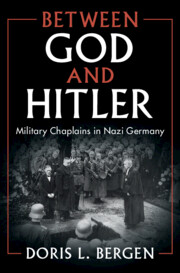Refine search
Actions for selected content:
15401 results in Military history
Dedication
-
- Book:
- Holding Out
- Published online:
- 31 March 2023
- Print publication:
- 20 April 2023, pp v-vi
-
- Chapter
- Export citation

Between God and Hitler
- Military Chaplains in Nazi Germany
-
- Published online:
- 14 April 2023
- Print publication:
- 11 May 2023
3 - Britain into Battle
- from Part II - “Imminent Invasion!”
-
- Book:
- When Men Fell from the Sky
- Published online:
- 21 March 2023
- Print publication:
- 13 April 2023, pp 69-83
-
- Chapter
- Export citation
11 - Race at Heart
- from Part IV - Lynching in Germany, 1943–1945
-
- Book:
- When Men Fell from the Sky
- Published online:
- 21 March 2023
- Print publication:
- 13 April 2023, pp 242-256
-
- Chapter
- Export citation
Charts
-
- Book:
- When Men Fell from the Sky
- Published online:
- 21 March 2023
- Print publication:
- 13 April 2023, pp xii-xii
-
- Chapter
- Export citation
Archival Sources
-
- Book:
- When Men Fell from the Sky
- Published online:
- 21 March 2023
- Print publication:
- 13 April 2023, pp 280-284
-
- Chapter
- Export citation
Acknowledgements
-
- Book:
- When Men Fell from the Sky
- Published online:
- 21 March 2023
- Print publication:
- 13 April 2023, pp xiv-xvi
-
- Chapter
- Export citation
Introduction
-
- Book:
- When Men Fell from the Sky
- Published online:
- 21 March 2023
- Print publication:
- 13 April 2023, pp 1-20
-
- Chapter
- Export citation
Copyright page
-
- Book:
- When Men Fell from the Sky
- Published online:
- 21 March 2023
- Print publication:
- 13 April 2023, pp iv-iv
-
- Chapter
- Export citation
7 - A Civil Society against Two States
- from Part III - The Origins of the Resistance
-
- Book:
- When Men Fell from the Sky
- Published online:
- 21 March 2023
- Print publication:
- 13 April 2023, pp 162-182
-
- Chapter
- Export citation
8 - The Lynching of Allied Airmen
- from Part IV - Lynching in Germany, 1943–1945
-
- Book:
- When Men Fell from the Sky
- Published online:
- 21 March 2023
- Print publication:
- 13 April 2023, pp 187-203
-
- Chapter
- Export citation
Contents
-
- Book:
- When Men Fell from the Sky
- Published online:
- 21 March 2023
- Print publication:
- 13 April 2023, pp v-viii
-
- Chapter
- Export citation
10 - Lynch Mobs
- from Part IV - Lynching in Germany, 1943–1945
-
- Book:
- When Men Fell from the Sky
- Published online:
- 21 March 2023
- Print publication:
- 13 April 2023, pp 221-241
-
- Chapter
- Export citation
Index
-
- Book:
- When Men Fell from the Sky
- Published online:
- 21 March 2023
- Print publication:
- 13 April 2023, pp 342-356
-
- Chapter
- Export citation
Notes
-
- Book:
- When Men Fell from the Sky
- Published online:
- 21 March 2023
- Print publication:
- 13 April 2023, pp 285-320
-
- Chapter
- Export citation
6 - The Sequences of Aid
- from Part III - The Origins of the Resistance
-
- Book:
- When Men Fell from the Sky
- Published online:
- 21 March 2023
- Print publication:
- 13 April 2023, pp 134-161
-
- Chapter
- Export citation
Bibliography
-
- Book:
- When Men Fell from the Sky
- Published online:
- 21 March 2023
- Print publication:
- 13 April 2023, pp 321-341
-
- Chapter
- Export citation
2 - The Repression of the Republic’s “Francs-Tireurs”
- from Part I - Blitz-Invasion in France, or Resistance Crushed
-
- Book:
- When Men Fell from the Sky
- Published online:
- 21 March 2023
- Print publication:
- 13 April 2023, pp 39-66
-
- Chapter
- Export citation
Part II - “Imminent Invasion!”
-
- Book:
- When Men Fell from the Sky
- Published online:
- 21 March 2023
- Print publication:
- 13 April 2023, pp 67-108
-
- Chapter
- Export citation
Conclusion
- from Part IV - Lynching in Germany, 1943–1945
-
- Book:
- When Men Fell from the Sky
- Published online:
- 21 March 2023
- Print publication:
- 13 April 2023, pp 257-266
-
- Chapter
- Export citation
